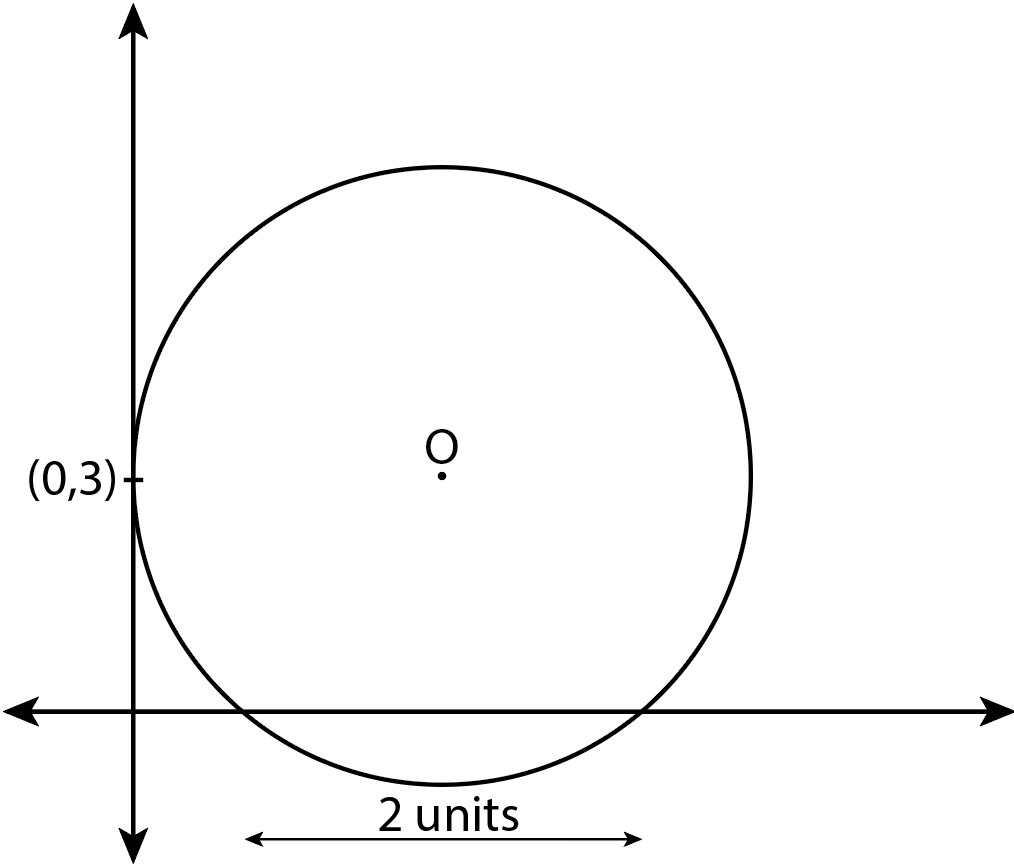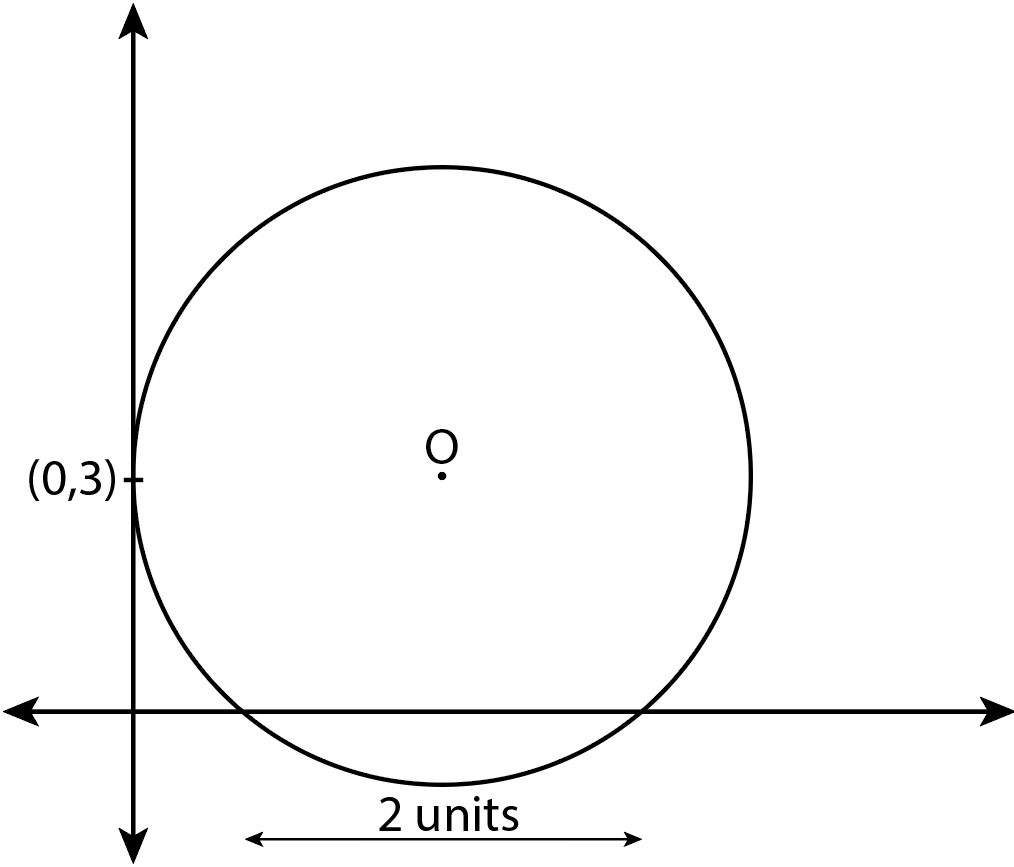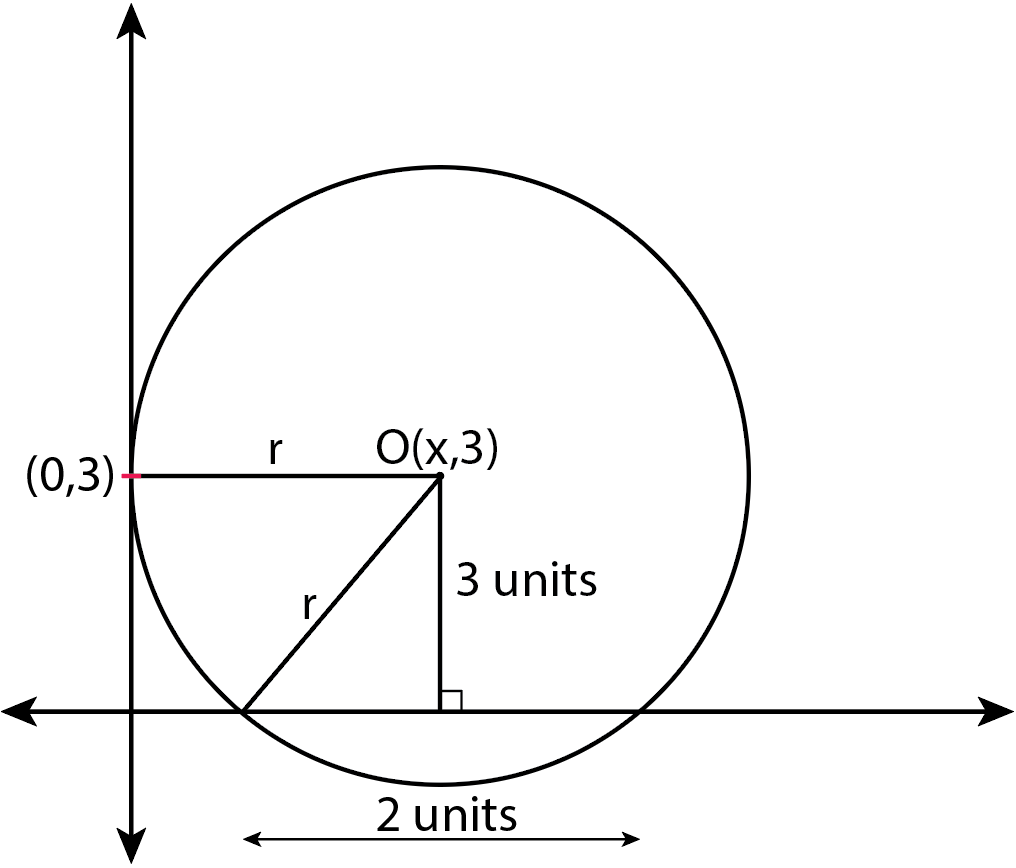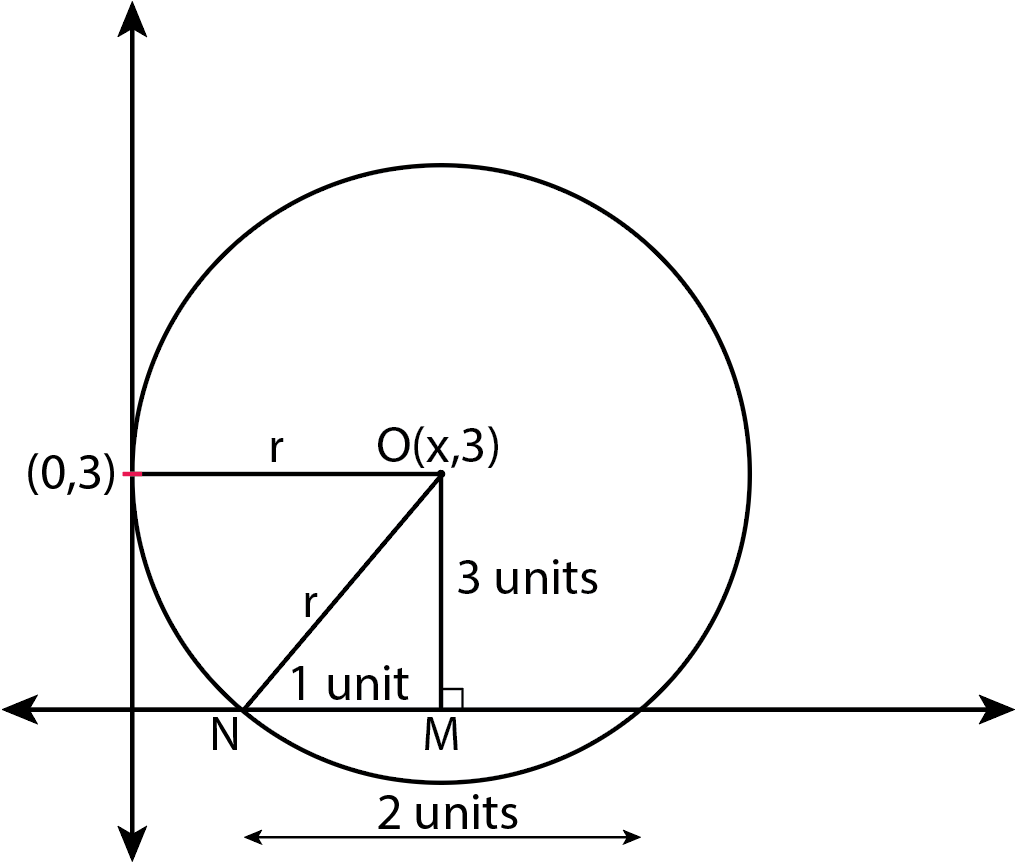
Find the centre of the circle touching Y-axis at (0,3) and making an intercept 2 units on positive X-axis is
A. $\left( {\sqrt {10} ,3} \right)$
B. $\left( {3,\sqrt {10} } \right)$
C. $\left( { - \sqrt {10} ,3} \right)$
D. $\left( { - \sqrt {10} , - 3} \right)$
Answer
571.2k+ views
Hint: Let the equation of circle be ${x^2} + {y^2} + 2gx + 2fy + c = 0$ .
Using the information provided in question find the value of f.
Now that we have the value of g, we can find the value of g using the formula \[2\sqrt {{g^2} - {f^2}} = 2\] .
Thus, we get the centre of the circle as (g,f).
Complete step-by-step answer:
It is given that a circle is touching the Y-axis at (0,3) and making an intercept 2 units on the positive X-axis.

Let the equation of the circle be ${x^2} + {y^2} + 2gx + 2fy + c = 0$ ... (1)
The circle touches Y-axis, so, $c = {f^2}$ ... (2)
Substituting equation (2) in equation (1) gives
${x^2} + {y^2} + 2gx + 2fy + {f^2} = 0$ ... (3)
As given, the circle touches the Y-axis at (0,3).
So, the point (0,3) must lie on the circle i.e. it must satisfy the equation of circle (equation (3)).
$\Rightarrow $ Substituting the values x = 0 and y = 3, in equation (3)
$\Rightarrow {\left( 0 \right)^2} + {\left( 3 \right)^2} + 2g\left( 0 \right) + 2f\left( 3 \right) + {f^2} = 0$
$\therefore 9 + 6f + {f^2} = 0$
$
\Rightarrow {f^2} + 2\left( 3 \right)\left( f \right) + 9 = 0 \\
\Rightarrow {\left( {f + 3} \right)^2} = 0 \\
\Rightarrow f + 3 = 0 \\
\Rightarrow f = - 3 \\
$
It is also given that, circle makes an intercept of 2 on the positive X-axis.
So, \[2\sqrt {{g^2} - {f^2}} = 2\]
$
\Rightarrow \sqrt {{g^2} - {f^2}} = 1 \\
\Rightarrow \sqrt {{g^2} - {{\left( { - 3} \right)}^2}} = 1 \\
\therefore \sqrt {{g^2} - 9} = 1 \\
$
Now, squaring both sides
$
\Rightarrow {g^2} - 9 = 1 \\
\Rightarrow {g^2} = 1 + 9 \\
\Rightarrow {g^2} = 10 \\
\Rightarrow g = \sqrt {10} \\
$
Thus, we get the centre of the circle as $\left( {\sqrt {10} ,3} \right)$ .
Option (A) is correct.
Note: It is given that a circle is touching Y-axis at (0,3) and making an intercept 2 units on the positive X-axis.

Thus, from the above diagram it is clear that, the coordinates of O will be O(x,3) as the perpendicular drawn from O to X-axis will be of length 3 units and radius of circle will be its x coordinate.

Also, the perpendicular from O to X-axis, bisects the 2 unit intercept. Let M be the point on X-axis be the foot of perpendicular from O. So, coordinates of M(1,0).

Also, OMN is a right angled triangle. So, applying Pythagoras’ theorem to it will give radius r.
\[\Rightarrow r = \sqrt {{3^2} + {1^2}} \]
\[
= \sqrt {9 + 1} \\
= \sqrt {10} \\
\]
Thus, we get the coordinates of O as $\left( {\sqrt {10} ,3} \right)$ . Here, x coordinate of O is equal to r.
So, the centre of the circle is $\left( {\sqrt {10} ,3} \right)$ .
Using the information provided in question find the value of f.
Now that we have the value of g, we can find the value of g using the formula \[2\sqrt {{g^2} - {f^2}} = 2\] .
Thus, we get the centre of the circle as (g,f).
Complete step-by-step answer:
It is given that a circle is touching the Y-axis at (0,3) and making an intercept 2 units on the positive X-axis.

Let the equation of the circle be ${x^2} + {y^2} + 2gx + 2fy + c = 0$ ... (1)
The circle touches Y-axis, so, $c = {f^2}$ ... (2)
Substituting equation (2) in equation (1) gives
${x^2} + {y^2} + 2gx + 2fy + {f^2} = 0$ ... (3)
As given, the circle touches the Y-axis at (0,3).
So, the point (0,3) must lie on the circle i.e. it must satisfy the equation of circle (equation (3)).
$\Rightarrow $ Substituting the values x = 0 and y = 3, in equation (3)
$\Rightarrow {\left( 0 \right)^2} + {\left( 3 \right)^2} + 2g\left( 0 \right) + 2f\left( 3 \right) + {f^2} = 0$
$\therefore 9 + 6f + {f^2} = 0$
$
\Rightarrow {f^2} + 2\left( 3 \right)\left( f \right) + 9 = 0 \\
\Rightarrow {\left( {f + 3} \right)^2} = 0 \\
\Rightarrow f + 3 = 0 \\
\Rightarrow f = - 3 \\
$
It is also given that, circle makes an intercept of 2 on the positive X-axis.
So, \[2\sqrt {{g^2} - {f^2}} = 2\]
$
\Rightarrow \sqrt {{g^2} - {f^2}} = 1 \\
\Rightarrow \sqrt {{g^2} - {{\left( { - 3} \right)}^2}} = 1 \\
\therefore \sqrt {{g^2} - 9} = 1 \\
$
Now, squaring both sides
$
\Rightarrow {g^2} - 9 = 1 \\
\Rightarrow {g^2} = 1 + 9 \\
\Rightarrow {g^2} = 10 \\
\Rightarrow g = \sqrt {10} \\
$
Thus, we get the centre of the circle as $\left( {\sqrt {10} ,3} \right)$ .
Option (A) is correct.
Note: It is given that a circle is touching Y-axis at (0,3) and making an intercept 2 units on the positive X-axis.

Thus, from the above diagram it is clear that, the coordinates of O will be O(x,3) as the perpendicular drawn from O to X-axis will be of length 3 units and radius of circle will be its x coordinate.

Also, the perpendicular from O to X-axis, bisects the 2 unit intercept. Let M be the point on X-axis be the foot of perpendicular from O. So, coordinates of M(1,0).

Also, OMN is a right angled triangle. So, applying Pythagoras’ theorem to it will give radius r.
\[\Rightarrow r = \sqrt {{3^2} + {1^2}} \]
\[
= \sqrt {9 + 1} \\
= \sqrt {10} \\
\]
Thus, we get the coordinates of O as $\left( {\sqrt {10} ,3} \right)$ . Here, x coordinate of O is equal to r.
So, the centre of the circle is $\left( {\sqrt {10} ,3} \right)$ .
Recently Updated Pages
Why are manures considered better than fertilizers class 11 biology CBSE

Find the coordinates of the midpoint of the line segment class 11 maths CBSE

Distinguish between static friction limiting friction class 11 physics CBSE

The Chairman of the constituent Assembly was A Jawaharlal class 11 social science CBSE

The first National Commission on Labour NCL submitted class 11 social science CBSE

Number of all subshell of n + l 7 is A 4 B 5 C 6 D class 11 chemistry CBSE

Trending doubts
What is meant by exothermic and endothermic reactions class 11 chemistry CBSE

1 Quintal is equal to a 110 kg b 10 kg c 100kg d 1000 class 11 physics CBSE

Difference Between Prokaryotic Cells and Eukaryotic Cells

What are Quantum numbers Explain the quantum number class 11 chemistry CBSE

What is periodicity class 11 chemistry CBSE

Explain zero factorial class 11 maths CBSE




